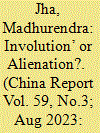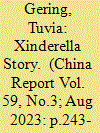|
|
|
Sort Order |
|
|
|
Items / Page
|
|
|
|
|
|
|
| Srl | Item |
| 1 |
ID:
193184


|
|
|
|
|
| Summary/Abstract |
This study evaluates the trade relations between Ethiopia and China as well as Ethiopia and India, and then compares the bilateral trade volume between them. It also examines the nexus between international trade and economic growth. Panel data were adopted to estimate the impact of China’s and India’s bilateral trade with Ethiopia for the 25 years duration (1990–2015). The gravity model has been employed in order to evaluate and compare the bilateral trade between Ethiopia–China and Ethiopia–India. To examine the collected data SPSS has been employed. The study also outlined three different hypotheses and examined them based on the consistency of the statistical empirical result of the study as well as the positive unconditional coherence with previous academic literature. The result demonstrates the bilateral trade between Ethiopia–China, 0.321, was found to be higher than Ethiopia–India, 0.136. The study’s empirical result also highlights that the influence of geographical proximity alone cannot be a determinant effect on bilateral trade, and discovers a significant linear relationship between a bilateral trade agreement (BTA) and a partner country’s economic size.
|
|
|
|
|
|
|
|
|
|
|
|
|
|
|
|
| 2 |
ID:
193182


|
|
|
|
|
| Summary/Abstract |
This article explores the Chinese media coverage of anti-Asian hate incidents in the USA during the COVID-19 pandemic. It sheds light on how xenophobia against Asians has been presented and discussed in the PRC press. Qualitative thematic analysis is used to identify key themes in the coverage of anti-Asian hate incidents in the two CCP-controlled newspapers: People’s Daily and Global Times. This article demonstrates that hate crimes against Asian Americans, an undoubtedly severe and complex problem for US society and politics, provide CCP-controlled media with a convenient opportunity to criticise the Other and focus on issues important to China’s identity. While blaming the discriminatory attitude in the USA towards Asians, the Chinese newspapers also use racialised stereotyping of Asian Americans as a ‘model minority’ and support the idea of Asians being alien to the USA. Remarkably, the Chinese media rarely devote special attention to victims of Chinese origin. Our observations contradict some earlier findings about discursive and reporting practices used in Chinese newspapers, that is, framing of violence and protests and selection of news sources, and showcase that these practices are pretty flexible and can adapt to better fit the particular context.
|
|
|
|
|
|
|
|
|
|
|
|
|
|
|
|
| 3 |
ID:
193183


|
|
|
|
|
| Summary/Abstract |
This study assesses China’s power–capital economy model, linking it to cultural tightness and comprehensive wealth. The analysis indicates that cultural tightness interacts with the power–capital economy, and unequal distribution of diverse tangible and intangible wealth might result from differences in cultural capital. Power–capital-based inequality widened during the reign of Xi Jinping. Of note, the worsened inequality would be unsolvable because of the political power or government-led power–capital-based inequality. Viewed from the comprehensive wealth framework (CWF) perspective, enhancing a power–capital economy would not contribute to sustainability because the system might contribute to unequal distribution of comprehensive wealth between advantaged and disadvantaged groups regarding power capital.
|
|
|
|
|
|
|
|
|
|
|
|
|
|
|
|
| 4 |
ID:
193179


|
|
|
|
|
| Summary/Abstract |
‘Nei Juan (内卷)’, translated as ‘involution’, was the ‘buzzword’ in Chinese social media in the year 2020. With ‘involution’, two more phenomena widely known as the ‘Sang Wenhua (丧文化)’, loosely translated as the ‘culture of dispiritedness’ and ‘Tangping Zhuyi (躺平主义)’, loosely translated as ‘lying flat-ism’, gained currency. If ‘involution’ is the issue the urban youth of China is facing in a commercialised and competitive China of today, then ‘dispiritedness’ seems to be its symptom, and ‘lying flat-ism’ its cure being adopted by the ‘dispirited’ youth. As a result, a few questions naturally arise. Is ‘involution’ a new issue that the Chinese urban youth is encountering today? Or is ‘involution’ in itself yet another symptom of a larger issue, ‘alienation’? My inquiry into these questions makes me turn towards films. To find the answers, I take up the works of Jia Zhangke, the central theme of whose works I describe as ‘the desultory wanderings of the alienated souls’. I argue that a critical and close reading of his ‘Hometown Trilogy’, will present us with such youth, who in the face of the rapid changes brought by the post-1979 economic reforms, were filled with a sense of powerlessness, meaninglessness, normlessness, isolation and self-estrangement, all forms of alienation as proposed by Melvin Seeman. I also look into the genesis of ‘involution’ and its manifestation to argue that the Chinese urban youth experiencing ‘involution’ and thereby ‘dispiritedness’, are experiencing the same subjective feelings of alienation as experienced by the youth in the Jia’a ‘Hometown Trilogy’.
|
|
|
|
|
|
|
|
|
|
|
|
|
|
|
|
| 5 |
ID:
193181


|
|
|
|
|
| Summary/Abstract |
With the incorporation of the State Administration for Religious Affairs (SARA) into the Chinese Communist Party’s (CCP) United Front Work Department in 2018, religious affairs have been brought back into the direct control of the Party. While SARA has retained its name, it is no longer an independent state agency. Five further legal measures were introduced from 2019 to 2021. This review essay examines these legal changes in order to update the dominant understanding of Xi Jinping’s attempt to reshape religious order in the hands of the CCP. The specific creation of regulations on Islamic affairs and the Internet also responds to Xi’s perceived problems regarding religious affairs in the contemporary era. Under the new measures, the state has demanded clear administration of religious groups, creating functions and positions like those in the Party’s branches. Beijing has further increased its control over religious personnel by establishing files on each of them, including details of any misconduct, in order to assess their trustworthiness. This essay concludes that the CCP continues to work toward the final eradication of religions in a Marxist manner and that China’s practices differ from existing international legal norms to which, at least nominally, China adheres as a signatory.
|
|
|
|
|
|
|
|
|
|
|
|
|
|
|
|
| 6 |
ID:
193180


|
|
|
|
|
| Summary/Abstract |
The China Story, also known as Xi Jinping’s Chinese Dream of the Great Rejuvenation of the Chinese Nation, is widely accepted as the central narrative for the leadership’s ideological and political legitimacy-building efforts. Despite its significance and the widespread attention it has received in the decade since its inception, surprisingly little literature has examined the Chinese Dream through the lens of narrative theory. This article seeks to close this gap by offering a structural narratological analysis of the China Story. It illuminates how the narrative comprises policy-oriented rhetorical frames that form overarching themes that direct party-state actions and support Xi Jinping’s status as the ‘core’ leader. The paper argues that as a ‘master narrative’, it seeks to provide a spiritual foundation and a compelling vision of a strong, prosperous, and unified China under the rule of the Chinese Communist Party.
|
|
|
|
|
|
|
|
|
|
|
|
|
|
|
|
|
|
|
|
|